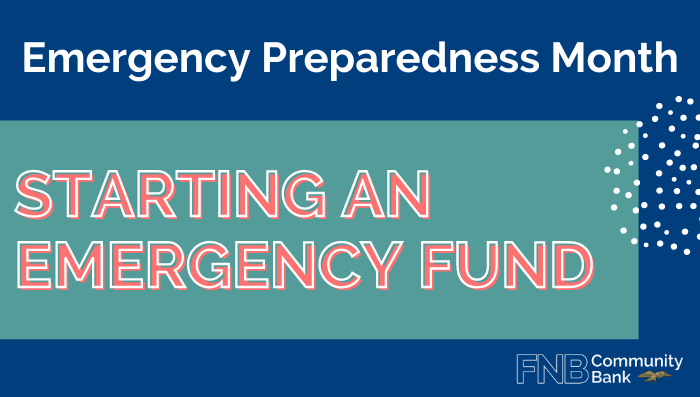
Starting an Emergency Fund
09/01/2020
Of all the years to recognize Emergency Preparedness Month, 2020 seems the most fitting. This year has thrown a lot at us and it’s important to remember how quickly life can change. A few weeks become a few months and, if you’re part of the more than 13 million Americans on unemployment right now, you’re feeling the pressure.
All told, more than 30 million Americans have lost some or all of their income because of the COVID-19 pandemic.
Now more than ever people are realizing the importance of emergency funds. They aren’t just for natural disasters, they’re largely to protect yourself and your family for whatever unforeseen circumstance comes your way. Unfortunately, nearly ¼ of Americans can’t afford a $100 emergency in cash, let alone a month’s worth of expenses or six months of expenses.
Even if you’re more strapped than ever, there are some simple ways to build that initial emergency nest egg. Saving $1000 might feel like a big endeavor, but it’s just a recommended goal. How you get there is up to you and your individual financial situation.
Set it and forget it
Something is always better than nothing. Even if you can’t dedicate large amounts to set aside, try to put something in each week. Even $5 a week turns into $20 which, over the course of a year, becomes $260. No matter what amount you start with, you’ll have something set aside which can come in handy.
If you’re looking for a safe place to save up and are interested in some interest growth, you could start or transfer a savings account with FNB. A savings account with FNB is easy to use and has an automatic direct deposit function. So, you can set weekly or monthly deposit goals and change them whenever. If you find yourself making a little more money or squirreling away a little extra, you can deposit it into your savings account for safe keeping.
Where to keep it
Do not keep your emergency fund in your checking account. As long as your money is somewhere easily accessible like your checking account, the more likely you are to spend it. At the same time, experts suggest not keeping your emergency fund in a certificate of deposit (CD) account or investing in bonds, since CDs and bonds can take some time to cash out. You don’t want your emergency funds to be totally accessible, but you also don’t want them to be completely inaccessible either.
Instead, you should keep your emergency fund in a savings account of some kind. By doing so you can earn interest and access the money within at least 24 hours if/when you need it. You can get started building your emergency fund if you already have a savings account. You don’t necessarily have to make a separate one just for this fund, but you could if you wanted to.
As long as your funds are accessible when you need them to be and you can keep track of how your savings is growing, you’re protecting your financial future.
Just a launch pad
Once you’re able to hit that first $1000 in your emergency fund, you should be proud! Nearly 70% of Americans don’t have $1000 saved and many of those surveyed didn’t have any savings at all. An emergency fund can certainly help in a pinch, but it’s not likely to sustain you long term. So, it’s important to keep growing your savings even if you have a retirement plan in place. You want to avoid dipping into your retirement savings if at all possible. Those savings are often investments and anytime you take any amount away they cannot continue to grow at the same pace.
Experts say you should have between 3-6 months of living expenses saved up in case of long term unemployment. That amount varies for everyone, so this handy emergency fund calculator can help determine what you should aim for.
Part of the 3-6 month fund is to keep folks from relying on credit cards to keep them afloat. While using credit can certainly help in the short term, interest fees add up quickly. The last thing you want to do, especially if you’re coming out of unemployment, is to be forced to funnel all your earned money into repaying debt. By saving incrementally you can protect yourself, and your credit score, from future mishaps.
Conclusion
2020 has been a difficult year for many people and launching an emergency fund isn’t a fix-all. However, if you’re able to set aside even a dollar at a time you’re doing yourself a favor. Having a plan is what emergency preparedness is all about, so this month take stock of what emergency plans you have in place. An emergency fund is a great place to start.

